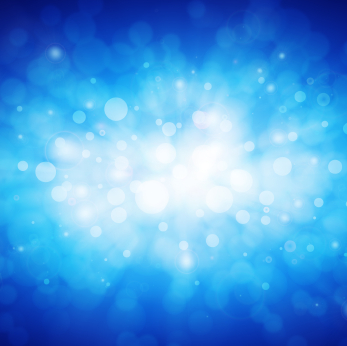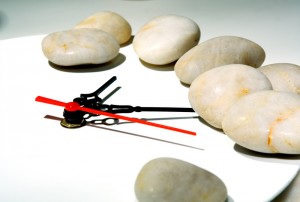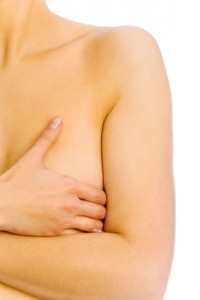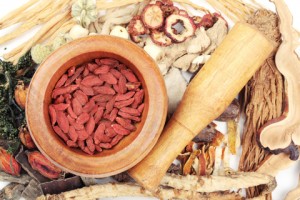Wednesday Bubble: More flack about flaxseed
First Bubble of the year!
Ya know, the news on flaxseed continues to be less than stellar, at least in so far as its effect (or lack thereof) on hot flashes. And while the flaxseed story continues to build on benefits in terms of bone health and even breast cancer reduction (see these links), you may want to seek alternatives when those flashes start taking over.
In fact, results of a well-designed, scientific, controlled study in which women ingested a daily flaxseed bar or a placebo bar failed to show much benefit at all. The study, published in this month’s Menopause journal, analyzed the effects of flaxseed (containing 400 mg of the estrogen like antioxidant, lignan, 6 gm of protein and 20% fiber) in 188 women in menopause who reported having anywhere from 4 to more than 10 hot flashes a day over a period of 9 months or more. Participants ate flaxseed or a placebo bar (containing 2 gram of protein and 20% fiber) for six weeks. The bars were eaten all at once or throughout the day and the women were asked to record the frequency and severity of their hot flashes in a personal diary.
The results? Regardless of whether or not the women ate flaxseed or placebo, their hot flashes were reduced fairly equally, with about about a third of the women in each group reduced their hot flash scores by 50% or more. Another third of women in each group noted that they didn’t experience any effect at all. Moreover, both types of bars caused gastrointestinal problems, namely bloating, gas and diarrhea, most like due to their considerable fiber content.
Meanwhile, if you like flaxseed, there is absolutely nothing wrong in eating it. It may help your bones, fight cholesterol and keep you regular. But in so far as the flashes go, you definitely want to look elsewhere.
[Evidently, this study first appeared online in September. Thanks to Ivan Oransky over at Reuters Health for the heads up. And if you want to read more, here’s their piece on the same study.
Read MoreNewsflash: black cohosh – one of these is not like the other
Love the first line of this editorial:
“Black cohosh preparations are not all the same.”
That is,
“Vigilance must be exercised when interpreting data.”
In other words, sometimes it appears that black cohosh is a significant and real alternative to hormones for battling hot flashes and even some other menopausal symptoms. And other times, it appears that it’s not. The reason? Product variability and dosage.
A bit of geek: you may recall that black cohosh is an herb from the buttercup family. Its scientific name is Cimicifuga racemosa. But, there are many different types (or species) of Cimicifuga and researchers say that when the continents split, these plants took different directions and ended up with distinct chemical compositions. Moreover, when they analyzed the products for certain active components, they found significant variability.
Add this to the fact that researchers studying black cohosh have used dosages ranging from 2.8 mg to 160 mg, and that these formulations were pure or were what they call “multibotanicals” (i.e. containing other herbs believed to be effective to qualm flashes and mood swings) and well, you have a veritable melting pot of clinical crap that defies logic. Add in a dash of more scientific geekdom know as a bell shaped response, in which low doses of a drug may be ineffective, moderate doses are effective and at higher doses, benefits disappear again, and well, it’s almost impossible to draw any firm conclusions.
Wow. Pretty scary, right?
The Menopause Industrial Complex will have you believe that the only effective preparations for ‘treating’ the disease they call menopause are pharmacological preparations manufactured by a large company and that has undergone rigorous, controlled scientific analysis. A lot of Western practitioners will have you believe that not only have herbs not be rigorously tested and studied under the same scientific conditions, but that they are downright ineffective and sometimes downright dangerous.
Guess what?
Both camps are incorrect. Because when you peruse the archives of the National Library of Medicine or esteemed journals like Maturitas or Menopause, you will find scientifically controlled evaluations of herbs. And, when researchers take the time to tease out data rather than drawing automatic conclusions (as the authors did in the piece I am referring to, which was published online in Maturitas at the end of December), they find that perhaps, the herbs are more effective than believed and that there are reasons for disparate results.
So, black cohosh, yay or nay?
Let’s get back to the original thought:
Black cohosh preparations are not all the same.
For me, a standardized extract that has undergone rigorous clinical study – Remifemin – works wonders. And I hear that it does for a lot of women. But not all women are the same either.
Two words.
Be vigilant.
Five more:
Don’t believe everything you read.
Happy New Year. Let’s approach this year as the year for opening our eyes and taking back our aging process.
Menopause? It’s not a disease and symptoms can be effectively and safely ameliorated with certain herbs. Just. Be. Vigilant.
Read More
Just 60 minutes a day…
keeps the symptoms at bay?
You know that I’m all about exercise, not only to maintain fluctuating weight but also to chase those moody blues away . But did you know that increasing your workout to at least 60 minute a day may actually improve wellbeing and lessen menopausal symptoms?
I stumbled across this piece last week and just knew that I had to share. And I am especially interested because it appears that too much exercise can set off early menopause (I’m still looking into this story). But to the study at hand.
Researchers, intrigued by the relationship between physical activity and menopausal symptoms, randomly assigned menopausal women to one of three groups:
- Less than 30 min/day physical activity
- Maintained or increased physical activity from 30 to 6o min/day
- Maintained or increased their physical activity to more than 60 min/day
During the time that participants were studied, their regular, habitual activity was defined as whenever they did something active for at least 10 minutes, e.g., household chores, transportation, etc. Additionally, all were encouraged to be more active (e.g. taking stairs versus an elevator) or at the very least, maintain their current activity levels during the time that they were enrolled in the 12 week study period.
Granted, while the outcomes were modest, the research did show that women who engaged in moderate to rigorous activity for at least an hour a day benefitted both in terms of feeling more positive about themselves and begin able to focus as well as in their personal relationships compared to peers who did 30 minutes or less a day. Overall, almost all menopausal symptoms were also lessened with the highest degree of physical activity. And, the researchers likened the improvements in mental wellbeing to the ability to, at the very least, maintain weight.
An hour of moderate physical activity daily? That’s a lot when your life is filled to the brim and your hours, maxed out. But, at the same time, mid age changes in body composition, hormonal fluctuations and increased risk of heart disease all point to one conclusion: it may be worth it to make the time. If you can’t get to the gym, at least take the stairs.
Treat yourself. You’re worth the hour.
Read MoreWednesday Bubble: More on breast tenderness, hormone replacement and breast cancer
More bad news on the hormone replacement front: if you are taking estrogen (conjugated equine estrogen) with progestin (medoxyprogesterone) for menopausal symptoms and experience breast tenderness, you may want to think twice.
Frankly, this news isn’t exactly new. Because back in 2009, UCLA researchers reported similar findings in the Archives of Internal Medicine. These newer data, provided by the same researchers at UCLA’s Jonsson Comprehensive Cancer Center and published online in Breast Cancer Research and Treatment only add to the hormone risk fodder.
The researchers say that in their research, they’ve consistently run across data that suggest that “estrogen plus progestin compared to estrogen alone, have a more marked effect on breast tissue,” possibly due to more growth, leading to greater density. According to the lead study author, Dr. Carolyn Crandall “higher breast density (has been shown to be) associated with a higher risk of breast cancer,” adding that “in women with extremely dense breasts, the cancer risk can be four to six times higher than for women whose breasts are not dense.”
In this update, Dr. Crandall and her colleagues reviewed data from the Women’s Health Initiative, specifically focusing on reports of new breast tenderness. At the study’s start, almost 12% of women taking estrogen alone or estrogen in combination with progestin reported having breast tenderness. However, by the first year, women in the combination hormone therapy group reporting onset of breast tenderness after starting hormones had a 33% greater risk of developing invasive breast cancer compared with their peers who did not have breast tenderness. And while estrogen alone also increased the risk for developing breast tenderness, the effect was less than that of the combined hormones, especially since it did not lead to an increased breast cancer risk.
So, what to make of these new data? If you are taking HRT and develop breast tenderness, you need to speak to your health practitioner, assess your risks and make a joint decision as to whether or not the benefit of fewer menopausal symptoms is worth the risk of possibly developing an invasive form of breast cancer. And if you are not yet using hormone therapy, you may just want to step back and think twice.
Buyer beware: hormone therapy is a slippery slope with bumps, bruises and perhaps serious disease. Is it worth it? Only you can decide.
Read MoreHot flashes, Traditional Chinese Medicine & JQF – it is time for an Rx change?
I am a huge fan of Traditional Chinese Medicine (TCM), having used various preparations over the past 20 years for numerous ailments. These preparations have been prescribed by a practitioner who is licensed and degreed in TCM and my experience, albeit anecdotal, has been nothing but positive. In fact, I have been using a TCM formulation for several years now to help battle numerous symptoms and in combination with other prescribed herbs, I’ve mostly won. That’s one of the main reasons that I am always intrigued when I stumble upon well-designed studies that demonstrate benefit, like this one in the journal Menopause.
A bit of context
TCM and other similar philosophies emphasizes various body systems that together, form a network or grid connected by a meridien, if you will, as well as the relationship of the body to its social and natural environment. Its primary focus on maintaining health and enhancing the body’s ability to fight off disease. TCM will not focus, for example, on treating specific pathogens but rather, on addressing non-specific factors that create disturbances or imbalances within a certain network. TCM also examines how these imbalances may occur in unique parts of a specific system, such as the heart and blood vessels and small intestine (all of which are part of the heart system) and how they change over time. Western medicine, on the other hand, focuses primarily on treating morbidities, or symptoms related to various conditions and diseases. You can read morerabout TCM in this post from last September.
In TCM, menopausal symptoms are believed to be related to a decline in yin or yang in the kidneys. One of the oldest prescriptions in TCM to reinforce kidney energy is known as ‘Qing E Fang’ (QEF) and the first record of its use dates back to the year 960. The preparation is a combination of four key ingredients that are mediated through estrogen receptors and expression, hence, its potential usefulness in menopause. (These ingredients, in case you are interested, are Cortex Eucommiae (whose bark and leaf have an antioxidant effect) Fructus Psoraleae (commonly used for bone health and to treat estrogen associated diseases), Semen Juglandis and Rhizoma Garlic.)
About the research
For this study, researchers used a formulation based on QEF known as Jiawei Qing’s Fang or, JQF, which used two of the four herbs (Cortex Eucommiae, Fructus Psoraleae) mentioned above. In JQF, they are combined with the herb, Salviae Miltiorrhizae, that has been used specifically to treat gynecological disorders and has properties that are similar to SERMs, drugs that mimic estrogen but are theoretically safer. The 72 women participating in the study were all perimenopausal and had severe and frequent hot flashes; they were randomly instructed to take JQF or placebo daily over 8 weeks. For a month thereafter, symptoms were evaluated using a menopause measure that looks at vasomotor, physical, psychosocial and sexual health). The women also kept daily diaries to record the frequency and severity of their flashes.
Notably, this is one of the first times that perimenopausal women have been the focus of a study that involves TCM. Moreover, in this study, researchers selected a formulation that worked on the kidney and also contained an herb that not only mimics SERMS but also improves blood circulation. And the findings? Women who randomly took JQF not only experienced significant improvements in their hot flashes, but also reported improvements in quality of life in terms of the impact of vasomotor and physical symptoms. Moreover, because Salviae Miltiorrhizae works on blood circulation, they also had reductions in the blood fats (triglyerides) which means that the formulation might also be beneficial in terms of heart disease prevention in menopausal women.
Is it time for a change of Rx for the change? Should you be seeking out a practitioner who can prescribe JQF and advise you on its best use for you? Or is it too early? JQF was well tolerated, although two women were found to have liver measures negatively affected in ways that did not require any medical intervention but did raise a few red flags and calls for more study. JQF represents a seemingly scientifically proven alternatives to hormone therapy. It’s refreshing to watch TCM come out of Asia and be increasingly incorporated into Western philosophy.
Wednesday Bubble: Cherry juice and sleep. Yup, sleep!
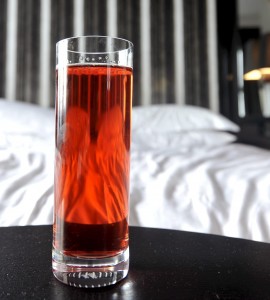 I have to admit; when I first saw the headline I was a wee bit skeptical:
I have to admit; when I first saw the headline I was a wee bit skeptical:
“Cherry juice gives a good nights’ sleep.’
Yeah, so does a knock on the head or an Ambien. But when I delved deeper, I found myself thinking, “wow,” who knew?!
Cherry juice, namely cherries of the Montmorency variety (aka a tart or sour cherry) have been found to significantly increase melatonin levels (a hormone that regulates sleep, among other functions) in the body, hence promoting sleep. In fact, researchers from Northumbria University in the North of England report that men and women who drank at roughly an ounce of tart cherry juice diluted with water twice a day for a week actually increased the time spent asleep by 25 minutes and experienced up to a 6% improvement in sleep quality. They also reported less time spent napping during the day than their peers who drank diluted fruit juice. And, when researchers delved deeper into cherry juice qualities, they found that it actually boosted melatonin levels by as much as 16%.
What’s most interesting about this study, at least from where I sit, is that the researchers say that they were originally interested in how tart or sour cherries would help muscles recovery from strenuous exercise because sleep plays an important role in the recovery process. However, this side finding means that cherry juice “has the potential to be applied as a natural intevention not only to athletes but to other populations with insomnia.”
Mind you, this study only examined the potential of tart cherry juice in 20 people up to age 40. Me? I would like to see if it works in postmenopausal women who experience major sleep disruptions due to hormone fluctuations. But if anything, I concur that the study definitely provides us with “more evidence surrounding the relationship between how we sleep and what we consume.”
Just a bit of cherry fodder for a Wednesday.
p.s. Not sure if the cherry pie at your Thanksgiving table can supplement that turkey zzzs but it certainly can’t hurt!
Read More






